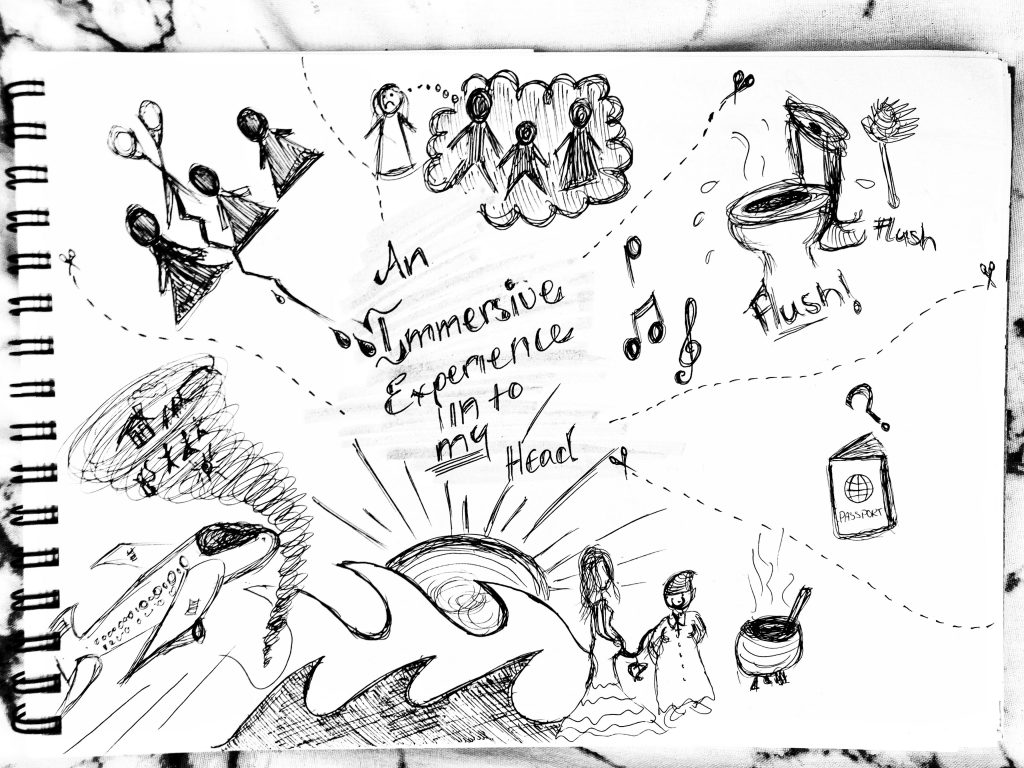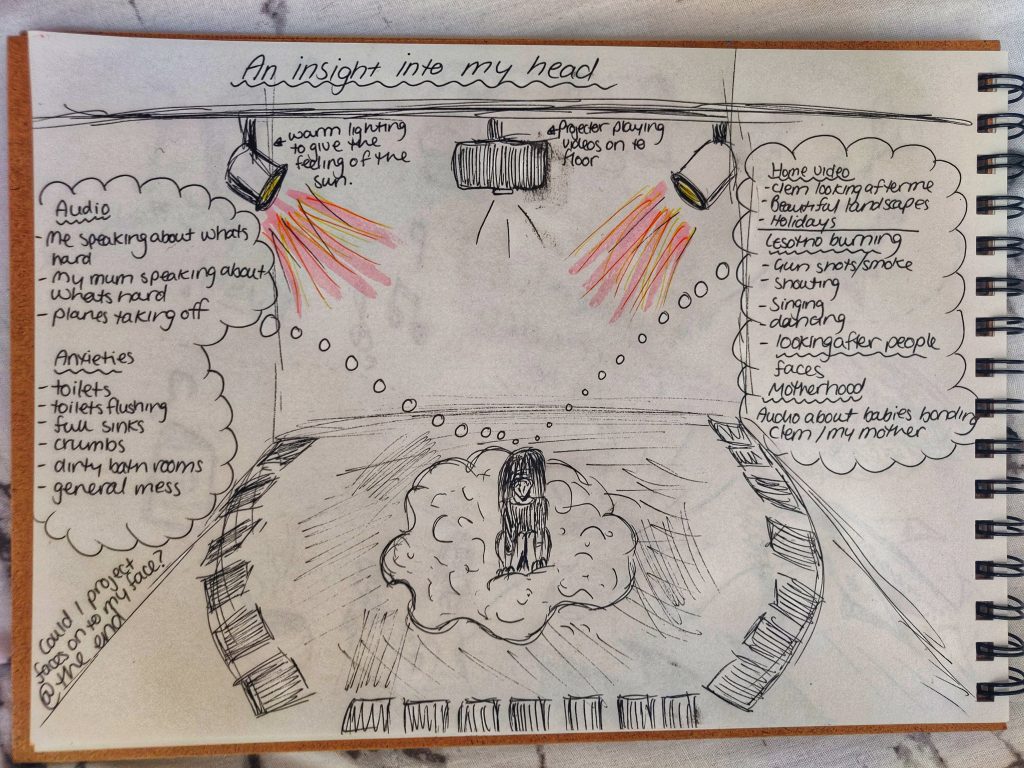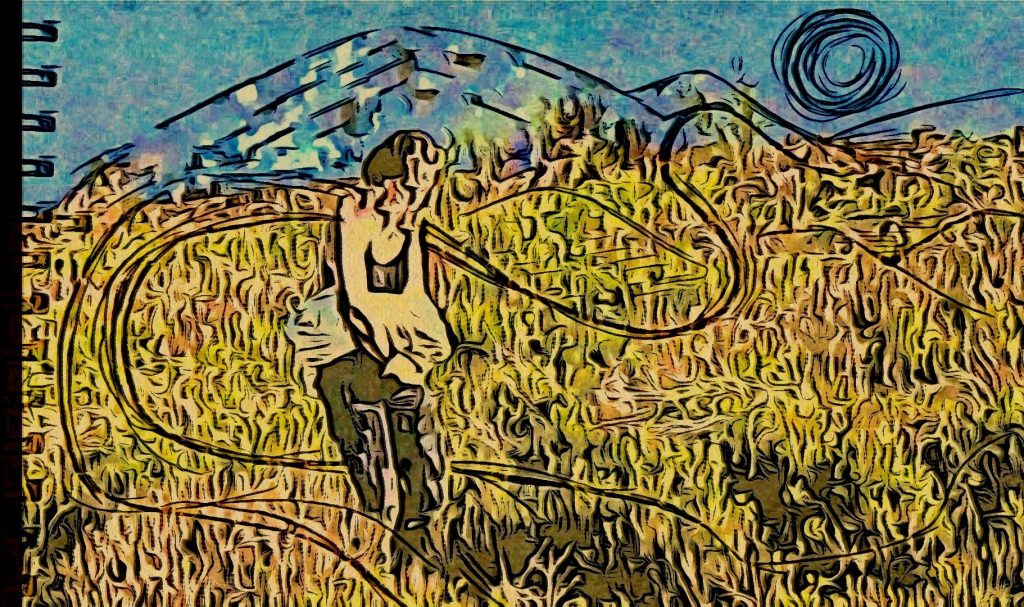
Initially, when I thought about what kind of piece I wanted to create, I knew I wanted a piece with the themes of identity and motherhood at its core. I felt that an autobiographical piece would be well suited to this because of my nomadic upbringing and the emotional difficulties that come along with living a transient life, with a third culture and childhood trauma. I spent weeks trying to figure out how I was going to create a performance that covered all these themes, but I couldn’t be productive because I found it to mentally difficult.
To help with this process, I sketched out what I was thinking about the themes I wanted to cover. It was vital for me to do this because I was struggling so much with having conversations about my ideas. I found conversations were extremely triggering and brought up aspects of trauma from my childhood and teenage years that I had been suppressing my whole life. Having a conversation about one thing as simple as the name of my nanny caused me to think about the catalysts of events that led to other moments of trama in my life. This made conversations difficult because although I would be talking about one thing, I could be thinking about something completely different at the same time due to invasive thoughts.
This is where sketching became an essential vehicle for me to sort through my ideas, memories, thoughts and feelings. The above image is a sketch I drew when I was trying to work through exactly what I was thinking and the key themes and moments that I wanted to explore. I knew I wanted to explore the idea of being transient, the idea that my culture was different from that of my parents. I wanted to explore how I felt about my nanny Clem in relation to being a mother figure and what that then meant about my relationship with my own parents and my identity. Looking into certain aspects of Basotho culture was important to me and looking into my feelings about being forcibly removed from my home by my parents was something that needed exploring.
It was easier to sketch my feelings out because it meant I did not have to find the language to express my self. All my sketches were created with tears involved, and this just reinforced my need to find a way of communicating my feelings without speech.
When creating this sketch, I also added some thoughts about some of my mental health problems such as depression, anxiety and obsessive compulsive disorder. This is why there is a toilet in the sketch; the toilet signifies my anxieties that have come from my obsessive compulsive disorder, and my need to control things and clean things. I know that this disorder started with me needing to find a way to control my life at a time when my life was out of my control, so it felt right that this is included in my thought process as these thoughts are all connected.

I used my sketchbook to sketch out how I wanted to perform this piece and work out how best it would be done in a theatre space. I felt that I wanted the performance to be more intimate, so I decided I would perform it in the round. The need for the performance to be intimate was due to my feeling that I needed to protect myself. I didn’t want a large audience of people I didn’t know; instead, I wanted a small invited audience. Part of the reason for this performance is to be cathartic both for myself and for my audience, but mainly for my self. As Eva Leveton says, drama can be used ‘as a tool for personal growth.’ (Leveton, 2010. P 81) I felt the round would help create a feeling of intimacy between me and my audience, thus making me feel safe while performing and giving the audience a better chance to explore the difficulty of the performance with me.
At this stage, I also wanted to use projections on the stage of home videos of my childhood, and audio of me having conversations about why it’s hard for me to talk about the subject matter of the performance. I wanted to create an overwhelming experience for my audience of overlapping images and audio clips of Lesotho burning during the 1998 military intervention and audio and video of flushing toilets and surfaces being repeatedly scrubbed clean. The cacophony of sound and images was meant to create an overwhelming feeling that continued throughout the process of me physically exerting myself by making my dough in the centre of the round. This overwhelming audiovisual experience was intended to replicate the feeling inside my head.

When Covid-19 hit the UK, and we went into lockdown, it became apparent that there was no way I would be able to perform the piece I had planned. I decided to start drawing and painting in my sketchbook to help work out what I was going to do and how I was going to move my piece forward.
When I think of home, I think of Lesotho, I always think about the warm weather. I think about the cosy feeling of the hot sun shining in through my bedroom window, creating a cocoon of warmth and safety. I then think about the yellow grass that has died in the hot sun and the crunching noise it makes when you walk over it. I think about getting ice lollies from street vendors on the walk back from school, and then I think about my nanny Clem. I remember her picking me up from school every day and how she would carry me on her back when I was little, and the walk home was too long. I remember what she smelt like, and I remember playing with the beads on her rosary that she always wore around her neck. Its a nice feeling going down memory lane, but then I start to remember things I would rather forget, and it all becomes painful and difficult again.
I think about my transient life and the feeling of always travelling and moving around and feeling like an alien every time we went somewhere new. It makes me miss Lesotho, my friends and Clem but most of all it reminds me of the constant struggle with my identity and the unrelenting feelings of guilt, anger, blame and loss that I struggle with on a day-to-day basis.
I began imagining all these feelings and memories as being a continuous journey, a journey that is extremely heavy and persistent, but that is also extremely precious. I created this picture so I could better visualise what I was thinking and feeling. This is where my piece changed from a piece of performance art created and performed in a theatre for an audience, to a piece of performance art performed for myself as a physically exhausting, transient, piece with minimal explanation and plenty of loose ends.